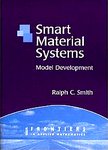版权所有:内蒙古大学图书馆 技术提供:维普资讯• 智图
内蒙古自治区呼和浩特市赛罕区大学西街235号 邮编: 010021

丛 书 名:Frontiers in Applied Mathematics
I S B N:(纸本) 9780898715835
出 版 社:SIAM Society for Industrial and Applied Mathematics
出 版 年:2005年
页 数:xxvii, 501 p. :页
主 题 词:Smart materials Mathematical models. Smart structures Mathematical models.
学科分类:08[工学] 080501[工学-材料物理与化学] 0805[工学-材料科学与工程(可授工学、理学学位)] 080502[工学-材料学]
馆 藏 号:201732634...
摘 要:Smart Material Systems: Model Development describes several novel applications currently under investigation that exploit the unique actuator and sensor capabilities of smart material compounds. In addition to present and projected applications, this book provides comprehensive coverage of both linear and nonlinear modeling techniques necessary to characterize materials in a manner that facilitates transducer design and control development. The author focuses on ferroelectric, magnetic, and shape memory compounds and also addresses applications exploiting amorphous and ionic polymers, magnetorheological compounds, and fiber optic sensors. Three classes of nonlinear models are discussed, all of which provide unified characterization frameworks for the broad class of combined compounds. An extensive discussion of structural models based on linear and nonlinear constitutive models is included, as is a chapter on numerical techniques for approximating solutions to the structural systems. The author also provides a synergistic treatment of material characterization, including significant discussion of the physics underlying nonlinear behavior, the development of nonlinear constitutive relations, the development of system models based on these constitutive relations, and the formulation of numerical techniques for approximating solutions to the resulting system models. To aid the understanding of both mathematical and physical terminology, an extensive glossary of terms is provided in an appendix. Furthermore, MATLAB software for representative models is provided at an accompanying website. By providing a unified treatment of both linear and nonlinear characterization frameworks, Smart Material Systems: Model Development encompasses both low to moderate drive levels, which constitute the primary focus of most present texts, and the high drive regimes dictated by present and future applications. This will significantly enhance the design of transducers and